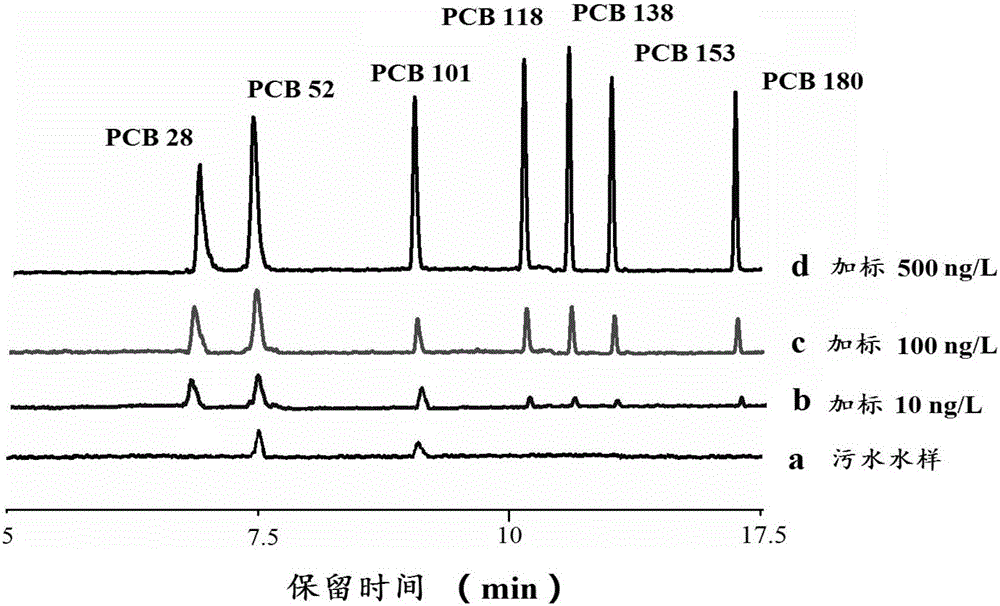Preparation method and application of magnetic metal - organic nanotube material
A technology of organic nanotubes and magnetic metals, applied in the field of environmental inspection, can solve the problems of low recycling rate and poor enrichment effect, achieve high sensitivity, easy desorption, and improve the effect of extraction
- Summary
- Abstract
- Description
- Claims
- Application Information
AI Technical Summary
Problems solved by technology
Method used
Image
Examples
Embodiment 1
[0052] Embodiment 1: the preparation of magnetic metal-organic nanotube material, such as figure 1 Shown:
[0053] 1. Solvothermal Synthesis of Fe 3 o 4 nanomaterials:
[0054] 2.7gFeCl 3 ·6H 2 O was dissolved in 50mL of ethylene glycol, and after stirring for half an hour, 5.75g of sodium acetate was added. After stirring for half an hour, it was transferred to an 80mL reaction kettle, and reacted at 473K for 8 hours. After cooling to room temperature, it was washed with ethanol and dried.
[0055] 2. Fe 3 o 4 Surface hydroxylation modification
[0056] 0.25gFe 3 o 4 Add to 50mL sodium dodecylsulfonate solution and stir for 4 hours. Note that 15 minutes of sonication is required for every 1 hour of stirring to ensure uniform dispersion. The samples were then washed and dried.
[0057] 3. Fe 3 o 4 Surface silanization treatment:
[0058] 0.15 g hydroxylated Fe 3 o 4 Disperse in 75 mL of absolute ethanol, add 0.66 mL of 3-aminopropyltrimethoxysilane dropwise an...
Embodiment 2
[0063] Example 2: Condition selection and optimization for improving the enrichment effect of magnetic metal-organic nanotube materials
[0064] The adsorption material prepared in Example 1 carried out magnetic solid-phase extraction:
[0065] Add 10mL of the sample to be tested into the 20mL headspace bottle, and add the prepared magnetic adsorption material into it. Extraction under the action of ultrasound for a period of time to complete the extraction process. After the extraction is completed, the extraction solution is removed under the action of an external magnetic field, and 5 mL of desorption solvent is added for ultrasonic desorption. After the desorption process was completed, the desorption solution was taken out and blown with nitrogen, and 50 μL of the desorption solvent was reconstituted and then directly entered into the instrument for analysis.
[0066] In order to improve the enrichment effect of magnetic solid-phase extraction of this material, the impo...
Embodiment 3
[0067] Example 3: Investigation of the detection limit, linear range and correlation coefficient of the method for detecting polychlorinated biphenyls based on magnetic solid-phase extraction and fast gas chromatography-tandem mass spectrometry
[0068] 1. Chromatography and mass spectrometry conditions:
[0069] Chromatographic column: DB-35MS chromatographic column (30m×0.25mm×0.25μm); column temperature adopts temperature program: initial 150°C and keep for 1min, 10°C / min to 290°C, keep for 4min; carrier gas: 1.0ml / min helium gas; collision gas: 1.5ml / min high-purity N 2 ; EI source is used for mass spectrometry; electron energy: 70ev; detector temperature is 280°C, ion source temperature is 250°C. Multiple reaction monitoring mode was used. See Table 1 for details.
[0070] Table 1 Chromatography-mass spectrometry parameters of seven polychlorinated biphenyls in gas chromatography tandem mass spectrometry MRM mode
[0071]
[0072] Under optimized conditions, the an...
PUM
 Login to View More
Login to View More Abstract
Description
Claims
Application Information
 Login to View More
Login to View More - R&D
- Intellectual Property
- Life Sciences
- Materials
- Tech Scout
- Unparalleled Data Quality
- Higher Quality Content
- 60% Fewer Hallucinations
Browse by: Latest US Patents, China's latest patents, Technical Efficacy Thesaurus, Application Domain, Technology Topic, Popular Technical Reports.
© 2025 PatSnap. All rights reserved.Legal|Privacy policy|Modern Slavery Act Transparency Statement|Sitemap|About US| Contact US: help@patsnap.com



